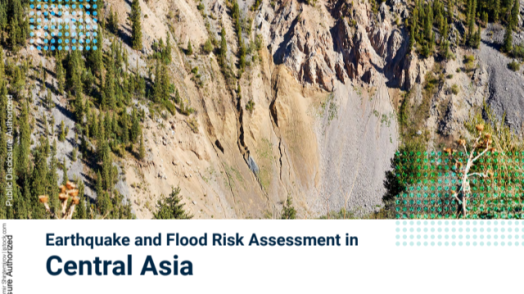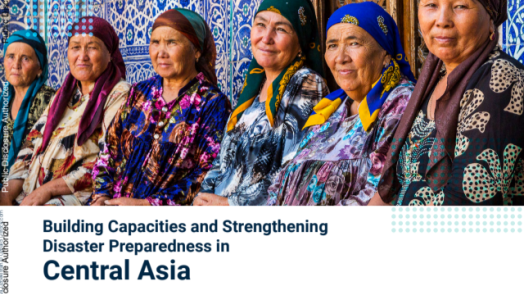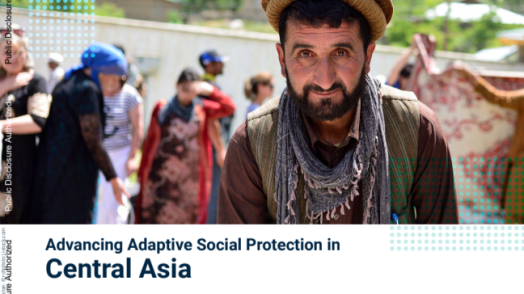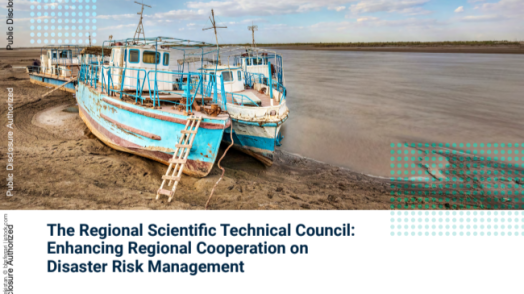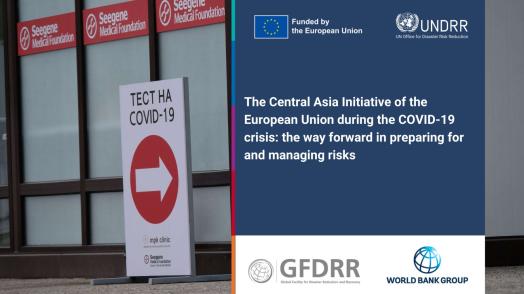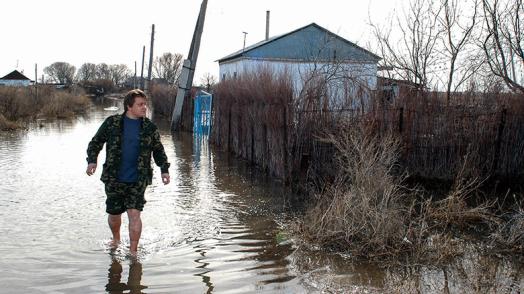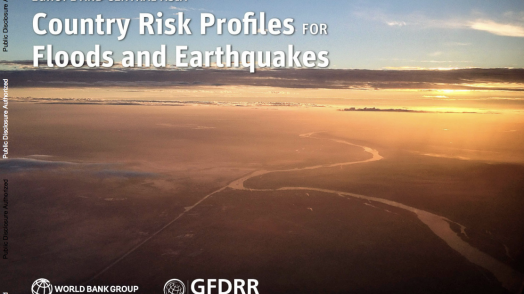(РУССКИЙ)
Background
The Central Asia region faces frequent low and high impact disasters, and is especially vulnerable to earthquakes, floods, droughts or landslides. Severity and occurrence of these natural disasters is increasing and often have a transboundary nature, exposing the growing populations of the five Central Asian countries: Kazakhstan, Kyrgyz Republic, Tajikistan, Turkmenistan and Uzbekistan.
Economic activity of the Central Asia region is vulnerable to adverse natural events. Over half of the region’s population lives in rural areas and 33% of the population relies on agriculture. Arable lands are often destroyed by seasonal flooding, and droughts also pose a major threat to crops. In addition, while the region depends on trade, many important international routes suffer annually from adverse natural events such as earthquakes, floods and landslides. In effect, disasters have already resulted in large financial impact in the region, having affected more than 2.5 million people and caused losses in excess of US$1.5 billion in the last two decades.
Governments in the Central Asia region play a key role in disaster response and recovery, which unfortunately translates into a significant burden on public finances, calling for increased and more systematic attention to disaster risk financing in the region. Furthermore, Disaster Risk Management (DRM) actions are already high on the agenda of Central Asian countries. However, a regional approach to DRM and financing can significantly benefit the countries in Central Asia by (i) providing common analytics and metrics; (ii) fostering training and sharing of knowledge and technology; and (iii) developing solutions for national and regional as well as transboundary issues.

Highlights
Learn about SFRARR in Central Asia
The European Union has entrusted World Bank and the Global Facility for Disaster Reduction and Recovery (GFDRR) with the implementation of the program Strengthening Financial Resilience and Accelerating Risk Reduction in Central Asia. The objective of the Program is to improve financial resilience and risk informed investment planning towards building disaster and climate resilience in Central Asia. Activities are implemented in the five Central Asian countries including Kazakhstan, Kyrgyz Republic, Tajikistan, Turkmenistan, and Uzbekistan. The Program has three operational components:
- Quantifying Regional Disaster Risks and Capacity Building on Risk Identification. Activities within this component aim to improve the understanding and quantification of disaster and climate risks in selected countries of Central Asia through identifying, assessing, mapping and modelling disaster and climate risks.
- Establishing Fundamental Awareness and Capacities for Financial Resilience at National and Regional Levels. Activities within this component aim to enhance awareness and fundamental capacities for financial protection in selected countries of Central Asia.
- Exposure Mapping for Improved Risk Analysis, Disaster Risk Management and Awareness. Activities within this component aim to collect new data on the exposure of assets at local levels to disaster and climate risk and to share and use this data for decision-making at national and sub-national levels for preparedness, risk reduction and risk financing.
Budget and duration
The Program has a budget of €4.6 million (including a €4.3 million contribution from the European Union and €300.000 of co-financing from GFDRR). The Program spans from July 2019 until 31 October 2024.
The Strengthening Financial Resilience and Accelerating Risk Reduction in Central Asia Program is being implemented in collaboration with several partners:
- European Union (EU): The Program is funded by the EU Directorate-General for International Partnerships (DG DEVCO) and is being implemented in close collaboration with the EU Delegation to Kazakhstan.
- United Nations Office for Disaster Risk Reduction (UNDRR): A complimentary EU-funded program supports UNDRR to engage in policy areas and regional cooperation under the Sendai framework and on aspects of community resilience in Central Asia.
- Center for Emergency Situations and Disaster Risk Reduction (CESDRR): The Program works in collaboration with the CESDRR based in Almaty, Kazakhstan, which was established in 2016 through the support from UNDRR and the United Nations Office for the Coordination of Humanitarian Affairs (UN-OCHA) with European Commission funding from the Directorate-General for European Civil Protection and Humanitarian Aid Operations (DG ECHO), with the objective of strengthening its role as a regional Center of Excellence on Disaster Risk Reduction. Within the Program, CESDRR is involved in activities related to regional engagement, such as the regional multi-hazard risk assessment and consideration of regional disaster risk financing mechanisms. For other activities, CESDRR is involved to the extent that contributes to their overall capacity building with the aim to upgrade it to become a ‘center of excellence’ on Disaster Risk Management in the long term.
- Other Partners: The Program is closely collaborating with stakeholders involved in DRR and Risk Financing in the Central Asia region, including Civil Society Organizations (CSOs), Non-Governmental Organizations (NGOs), and the private sector.
- The SFRARR Program Fact Sheet is available in English and Russian.
- An informational brochure of the SFRARR Program is available here in Russian and English languages.
Blogs & Stories
World Bank Feature Story (December 2019): Improving Regional Cooperation to Better Manage Disaster Risks in Central Asia. Read here.
World Bank Blog (November 2020): Natural disasters cost Central Asia $10 billion a year – Are we doing enough to prevent them? Read here.
World Bank Feature Story (October 2021): Celebrating Risk Reduction Heroes in Central Asia. Read here.
The joint feature by the GFDRR, World Bank, and United Nations Office for Disaster Risk Reduction (January 2022): The Central Asia Initiative of the European Union during the COVID-19 crisis: The way forward in preparing for and managing risks. Read here.
World Bank Blog (April 2022): How to support Central Asia build resilience against climate change and natural disasters. Read here.
World Bank Blog (July 2023): As global temperatures rise, Central Asia needs to enhance disaster preparedness. Read here.
Resources
Europe and Central Asia: Country Risk Profiles for Floods and Earthquakes. Learn more.
Global "Understanding Risk" Forum in Himeji, Japan
June 2024: The European Union - funded SFRARR program held a session on building a prepared and resilient Central Asia in the margins of the biannual Understanding Risk Forum in Himeji, Japan.
All the materials presented during regional and country-based workshops can be viewed and downloaded here.
Regional workshops
November 2021: Regional training on the disaster risk finance (DRF) tools: "Analytics for Informed Risk Finance in Central Asia". The training was organized together with the EU- funded Disaster Risk Finance Analytics Program and covered information on DRF principles and introduction to analytics tools and introduced financial risk assessment tool with example of application in Vietnam.
January 2022: The virtual workshop "Challenges of Multi-Peril Hazard Modeling at Regional Scale: Assessing Earthquake, Flood and Landslide Hazard in Central Asia". Read more on "Risk Assessment in Central Asia will contribute to measures against natural hazards" here.
February 2022: The virtual workshop "Vulnerability modelling for disaster risk assessment at the regional scale: an application in Central Asia". Read more on "Central Asian states are jointly preparing for natural hazards and building capacities in vulnerability modeling" here.
July 2022: The virtual workshop "Risk modeling for earthquake and flood disaster mitigation in Central Asia". Read more on "Workshop on earthquake and flood risk modelling contributes to disaster risk preparedness in Central Asia" here.
Country-based workshops on exposure mapping
The major goal of the workshop series was to develop an updated and harmonized database of exposed assets, crucial for effective risk mitigation in Central Asia. The five workshops each spanned over four days and covered existing methodologies for the development of regional-scale exposure database, underlining the importance of using datasets with different spatial scales, comprising remote-sensing and national-scale data sources.
The workshops were implemented with the support of a consortium of international and Central Asian technical experts led by RED (Risk, Engineering + Development).
Learn more about each workshop:
May 2021: Assets at Risk: Implementing Actions to Accelerate Risk Reduction in Kazakhstan. Read more here.
June 2021: Workshop on Exposure will be held in the Kyrgyz Republic. Read more here.
July 2021: How to build disaster resilience in Tajikistan: a workshop on mapping assets exposed to earthquakes, floods, and landslide hazards to be held online. Read more here.
October 2021: Towards Disaster Resilience in Uzbekistan. Read more here.
December 2021: Providing Turkmenistan with Tools for Accelerating Risk Planning and Reduction. Read more here.
Report presentations
December 2020 and January 2021: First meetings dedicated to the launch of the Regional Disaster Risk Assessment Task implemented by the consortium of technical experts led by RED (Risk, Engineering + Development)
- December 2020: EU project presents the Regional Disaster Risk Assessment report for Central Asia. Read more here.
- January 2021: Central Asia’s Regional Multi-Peril Risk Assessment Initiative Moves Forward. Read more here.
September 2021: How damaging are earthquakes in Central Asia? The new earthquake hazard assessment report has the answers. Read more here.
November 2021:
- Fluvial and pluvial flood hazard assessment conducted by the World Bank contributes to better-planned prevention of natural hazards. Read more here.
- EU-funded assessments on hazards, exposure, and vulnerability advance risk prevention planning across Central Asia. Read more here.
September 2022: Regional risk assessment for earthquakes and floods contributes to disaster risk management and financing activities in Central Asia. Read more here.
October 2022: Regional forum on disaster risk reduction: strengthening the resilience of Central Asia. Read more here.
Program meetings
June 2021: First Steering Committee Meeting of the Strengthening Financial Resilience & Accelerating Risk Reduction Program in Central Asia. Read more here.
March 2022: Second Steering Committee Meeting of the Strengthening Financial Resilience & Accelerating Risk Reduction Program in Central Asia was held online. Read more here.
March 2023: The Program held its online Third Steering Committee Meeting. The team has presented the development of the activities to date and the work plan for 2023 to the European Union representatives, members of the Regional Scientific-Technical Council, and National Coordinators for the Sendai Framework Program in Central Asia.
March 2024: The Program conducted the regular online meeting - Fourth Steering Committee Meeting. It was attended by the representatives of the European Union, members of the Regional Scientific-Technical Council, and National Coordinators for the Sendai Framework Program in Central Asia. The team presented the progress of activities to date and the work plan for 2024.
October 2024: The European Union (EU)-funded Program implemented by the Global Facility for Disaster Reduction and Recovery (GFDRR) and the World Bank, concludes its activities with a final two-day regional forum in Almaty. EU press release can be found here, more details about the event including photos and presentations can be found here.
The reports and more than 70 datasets developed under the Regional Multi-Hazard Risk Assessment task (components 1 and 3 of the Program) are available here. The keyword filter has to be set to “Central Asia” or “SFRARR”.
The hazard and risk estimates modeled include for floods, both current climate conditions and projections of climate conditions at 2080. Risk estimates for flood and earthquake at 2080 also include a projected change in population and urban growth for the residential building stock. The datasets allow data to be downloaded by country and sector, as csv/tiff/shp/zip files.

